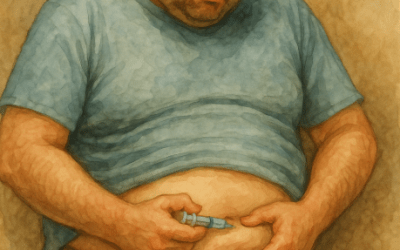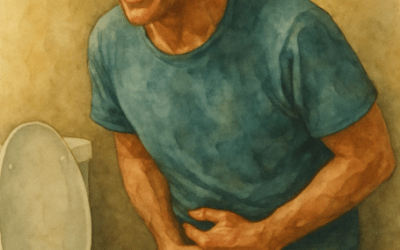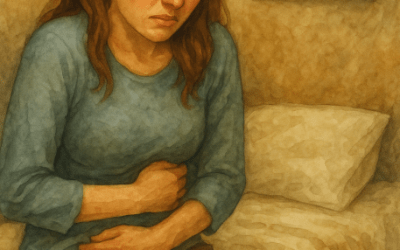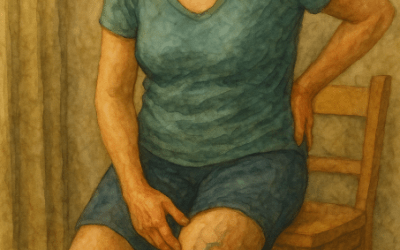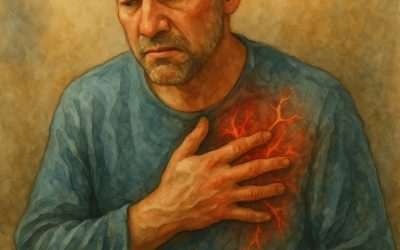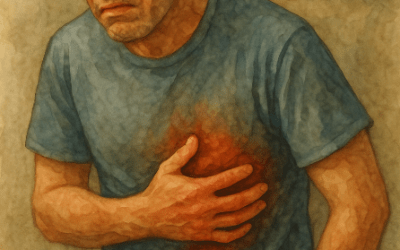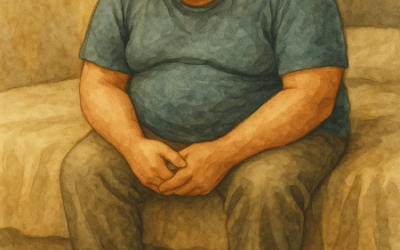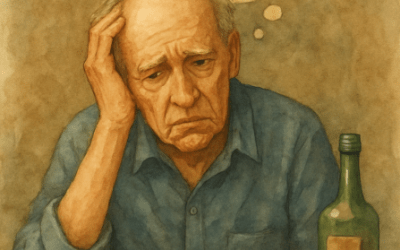The Invisible Line Between Grief and Depression
When Maria lost her father, she expected sadness, but she didn’t expect the emptiness that followed. Some days, she found herself laughing at old memories, while on others, she couldn’t get out of bed. At first, she thought it was normal—grief is unpredictable, after all. But as months passed, her world stayed gray. Unlike the ebb and flow of grief, her sadness never lifted. Even the things she once loved felt meaningless. Was this still grief, or was she slipping into something deeper?
Her experience highlights a question many face after loss: Where does grief end and depression begin? Though they share many symptoms, grief and clinical depression are not the same. Recognizing their differences is key to effective healing and knowing when to seek support.
“I kept telling myself, ‘Time will fix this,’ but the emptiness wouldn’t budge. Learning the difference between normal mourning and deeper despair finally helped me find the support I needed.”
When Sadness Transcends Time

How Grief and Depression Overlap – and Where They Differ
Grief and depression share deep sadness, emotional numbness, fatigue, and changes in sleep or appetite. Yet, the key difference lies in how these feelings manifest and evolve over time:
Emotional Waves vs. Persistent Sadness
- Grief often comes in waves. One moment can bring overwhelming sorrow, then a memory sparks comfort or laughter.
- Depression remains constant. A lingering sense of despair weighs you down, unaffected by distractions or positive moments.
Sense of Self-Worth
- Grieving individuals typically preserve self-esteem. They may feel lost without their loved one but do not see themselves as worthless.
- Depression involves self-loathing or feelings of worthlessness—people may believe they’re a burden or undeserving of care.
Response to Social Support
- Grief can find relief through connection—sharing memories or receiving compassion often eases sorrow, at least briefly.
- Depression leads to withdrawal, where even loved ones’ presence doesn’t alleviate the sense of isolation.
Hope vs. Hopelessness
- Grief holds onto hope. Over time, the bereaved learn to weave their loss into life, finding ways to honor it while moving forward.
- Depression fosters hopelessness, making the future appear meaningless or bleak, with no light at the end of the tunnel.
Signs That Grief May Be Turning into Depression or Complicated Grief
Grief is personal, but certain patterns suggest it may have evolved into complicated grief (prolonged grief disorder) or clinical depression:
🔹 Signs of Complicated Grief
✅ Persistent, Intense Longing: Unable to accept the loss, even after a year.
✅ Preoccupation with the Deceased: Constantly thinking about them in a way that disrupts daily life.
✅ Avoidance of Reminders: Refusal to discuss the person or avoidance of places linked to them.
✅ Emotional Numbness or Bitterness: Feeling stuck, unable to adapt emotionally.
✅ Inability to Function: Struggling with work, relationships, or self-care due to overwhelming grief.
🔹 Signs of Clinical Depression
✅ Loss of Interest in Everything: Even unrelated activities feel empty.
✅ Feelings of Worthlessness: Persistent negative self-view, shame, or guilt.
✅ Prolonged Emotional Numbness: A pervasive disconnection lasting months or years.
✅ Suicidal Thoughts: A sense that life is not worth living.
✅ Physical Symptoms: Headaches, stomach problems, or chronic pain reflecting deeper emotional distress.
When intense grief continues past a year, severely impairs daily functioning, or includes suicidal thoughts, seeking professional support is crucial.
“Grief is the echo of love, reminding us that even in absence, the bond remains alive.” — Emilia F.
When to Seek Help—and How to Cope
🚨 When to Seek Help
✔️ If grief remains severe beyond a year with no relief.
✔️ If daily tasks (work, self-care) become unmanageable.
✔️ If suicidal thoughts or self-harm emerge.
✔️ If social withdrawal grows extreme and persistent.
🌱 Strategies for Coping with Grief and Depression
Allow Yourself to Grieve
- Suppressing feelings prolongs suffering. Therapy, open discussions, or journaling help release emotions.
Build Rituals of Remembrance
- Honor loved ones with meaningful gestures—lighting a candle on special dates or creating memory books. It transforms longing into a tangible tribute.
Seek Social Support
- Isolation worsens sorrow. Connecting with local or online groups offers empathy and shared insight.
Engage in Healthy Routines
- Regular sleep, mindful exercise, and balanced meals anchor you when emotions feel turbulent.
Consider Professional Help
- Therapy (Cognitive Behavioral Therapy, for instance) guides you through overwhelming sadness or negative thought patterns.
- Medication may help if clinical depression is diagnosed, aiming to rebalance brain chemistry.
Things To Try This Week!
Share a Memory with a Loved One
- Recall a positive or humorous story about the person who passed. Whether in person or through a message, these recollections soothe the heart.
Nightly Reflection
- Dedicate five minutes before bedtime to note one dominant feeling of the day—whether sadness, gratitude, or relief. Recognizing emotional shifts can help you see where grief might be veering into deeper despair.
Community Connection
- If you suspect your sorrow leans into depression or complicated grief, check out local or virtual grief circles. Hearing others’ experiences and sharing your own can break the cycle of loneliness and self-doubt.
Conclusion
The Path To Healing
Though grief and depression can appear alike, they diverge in how deeply they erode one’s hope and sense of self. Grief, for all its pain, allows for movement and growth over time; depression can trap individuals in persistent darkness.
Knowing how to differentiate between the two is vital for seeking timely, proper support—be it personal reflection, communal support, or professional intervention. Healing doesn’t mean leaving love behind; it means learning to carry it in a healthier, forward-facing way. 💙
Differentiating grief from depression isn’t always clear, especially when both weigh so heavily on the heart.
Remember: it’s not time alone but the care you invest in your emotional health that truly fosters healing. Explore our cherish collections below for thoughtful resources, creative commemorations, and supportive connections—helping you navigate sorrow’s depths and find steady ground beyond loss.
More Reflections, More Growth
Embracing Hope: Healing Beyond Loss and Lasting Sadness
When the line between grief and depression blurs, seeking clarity and comfort becomes vital. Our All Things Cherish collection holds gentle guidance, soul-nurturing ideas, and a compassionate community that walk beside you on the path toward renewed emotional balance, even in the midst of profound sorrow.
Loss is complex, and the road to healing is different for everyone. These reflections offer insight, support, and guidance as you navigate this journey.
Grieving Type 1 Diabetes: Living by the Numbers and Still Losing Ground – Grief & Solace
Grieving type 1 diabetes is mourning the freedom lost to syringes and numbers. This story captures the heartbreak of fighting every day for balance, even when the odds never seem fair.
Grieving Ulcerative Colitis: Mourning a Life Interrupted by Pain
Grieving ulcerative colitis is mourning the spaces between battles—those fragile moments of peace constantly under threat. This story captures the strength it takes to live bravely while pain lurks just around the corner.
Grieving Urethral Syndrome: Mourning the Pain No One Talks About
Grieving urethral syndrome is mourning the quiet wars fought beneath brave smiles. This story captures the heartbreak of suffering that’s rarely seen but deeply felt.
Grieving Uterine Fibroids: When Pain and Loss Take Root Together
Grieving uterine fibroids is mourning both the life that hurt and the life that never had a chance to grow. This story captures the quiet sorrow of fighting battles hidden deep within.
Grieving Varicose Veins: Mourning the Pain Beneath the Surface
varicose veins is mourning the quiet burden no one sees. This story captures the resilience it takes to keep moving when every step feels heavier than the last.
Grieving Vasculitis: When the Body’s Rivers Turn Against Itself
Grieving vasculitis is mourning the pain that flows beneath the surface. This story captures the quiet devastation of loving someone whose very blood turned against them.
Grieving Viral Hepatitis: When Strength Fades Behind Closed Doors
Grieving viral hepatitis is mourning the fragile hopes shattered by unseen battles. This story captures the heartbreak of celebrating every small win while living in fear of the next fall.
Grieving Weight Disorders: Mourning the Body That Was Never Safe
Grieving weight disorders is mourning the years spent chasing an impossible peace. This story holds space for the sorrow of never feeling safe in your own skin—and for those who watched someone break under the weight of that war.
Grieving Wernicke-Korsakoff Syndrome: When Memory and Judgment Disappear Together
Grieving Wernicke-Korsakoff is mourning a mind unraveling in real time. This story captures the heartbreak of loving someone who forgets even the core of who they were—and who you were to them.
Explore Journeys of Healing and Solace:
Discover dedicated spaces that offer understanding, guidance, and connection through grief. From the loss of loved ones to life’s challenging transitions, each category provides a pathway to reflect, connect, and find peace in shared experiences.





